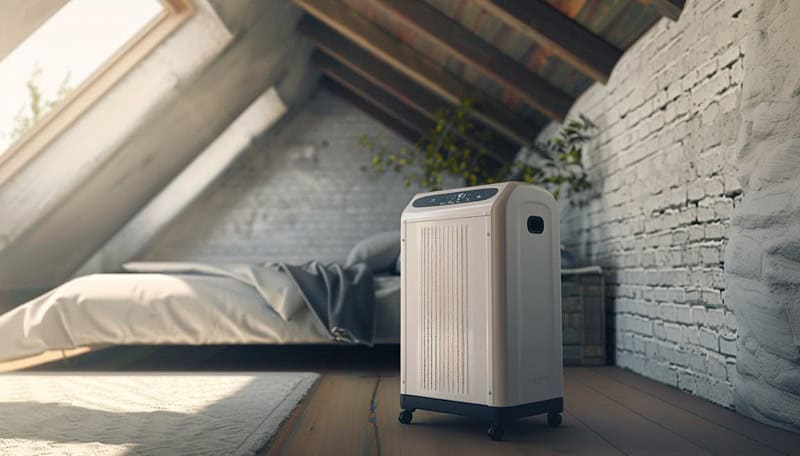Taking care of the environment in which we live is necessary, but there are certain places that we fail to take notice of. Among those is the attic; if not well maintained it can be a breeding ground for moisture. Moisture levels need to be controlled and this requires an attic dehumidifier whose function is to ensure that humidity does not go beyond a certain point thus preventing problems such as mould growth, wood rotting and insulation damage among others. This article gives essential information on what you should know about attic dehumidifiers before purchasing one.
Grasping The Significance Of An Attic Dehumidifier
The role played by your homes’ structure cannot be underestimated since it acts as a shield against external factors while also providing insulation. However, due to roof leaks, poor ventilation and fluctuations in temperatures among other causes; this area may accumulate moisture more than any other part thus becoming very wet sometimes. Too much dampness in any building has detrimental effects on its overall health but none so much like when it comes down with molds because they have been known to cause various allergic reactions including asthma attacks among others hence making it necessary for one to consider buying an attic dehumidifier.
Preventing Mold And Mildew Growth
The first reason why you should think about getting yourself an attic dehumidifier is prevention of mold or mildew infestation. If left unchecked these fungi can grow rapidly within 24 hours under favorable conditions thereby releasing spores into their surroundings which eventually find their way onto different surfaces through air currents leading to health problems like respiratory tract infections such pneumonia besides triggering allergic reactions such as sneezing fits followed by watery eyes then itching nose etc., therefore prompting us always keep our houses dry so that they create unconducive environments for their development.
Safeguarding Structural Integrity
Another thing that moisture does to houses is weakening them by causing wood to rot or metals rust. Beams rafters deckings among other parts of a building are mostly made out of timber and these materials can easily get damaged when exposed continuously over long periods without any protection against water. This is why it becomes vital for people living in areas prone to floods or those having leaking roofs fix them as soon as possible otherwise employ attic dehumidifiers so as not only save such crucial components but also secure overall stability and safety.
Improving Energy Efficiency
Further still, high volumes of humidity may interfere with proper functioning attic insulation thereby leading increased consumption energy which will be reflected through higher utility bills at end month. In simple terms, wet insulators cannot control temperatures as required therefore making heating ventilation air conditioning systems work harder than usual just keep homes warm during cold seasons hence resulting into more power usage thus increasing costs; this problem can however be solved by getting yourself an attic dehumidifier because it ensures that all coverings remain dry throughout seasons consequently improving performance while promoting savings.
How Does An Attic Dehumidifier Work?
Essentially, the main function performed by any given dehumidifying device is removal excessive amounts of moisture from air thereby reducing its content level. What this means is that such an equipment draws in damp air cools down until condensation occurs after which sends back dryness into space being treated. Additionally most models feature tanks where condensed water gets collected while others pump it out through hoses.
Main Components
Normally an attic dehumidifier comprises different parts namely:
- Fan – facilitates circulation within unit.
- Evaporator Coil – used cooling process.
- Condenser Coil – reheats before releasing outside room atmosphere.
- Water Collection System – stores or eliminates accumulated liquid.
- Humidistat – keeps track amount present.
Types Of Attic Dehumidifiers
There are two types of dehumidifiers for attics namely refrigerant and desiccant.
- Desiccant Dehumidifiers: These ones have the ability to take in moisture from air using certain materials called desiccants. They work well under low temperature conditions besides being less noisy compact compared with their counterparts.
- Refrigerant Dehumidifiers: This category operates by condensing water vapor from air through refrigeration cycle process which is more efficient at removing large quantities all together.
Choosing The Best Attic Dehumidifier
Before buying any dehumidifier, it is important to consider some factors that will enable you get one which meets your requirements as well suits prevailing conditions.
Dimension and Volume of Space
One must look into the dimension and volume of space when choosing an attic dehumidifier. In most cases, capacity is expressed in pints per day (PPD) which signifies the amount of moisture that can be extracted by the machine within a day. Evaluate your attic’s size in relation to the magnitude of humidity problem you have; this will enable you get it right on what capacity should be bought for. A bigger one or one with higher wetness levels requires a unit that has more power.
Energy Effectiveness
Power efficiency is a critical factor to consider especially if your dehumidifier will run non-stop throughout the year. Such models should bear rating from Energy Star which shows compliance with EPA standards on energy conservation set by Environmental Protection Agency (EPA). This saves operation costs while at the same time minimizing ecological impacts caused by these machines located in attics.
Noise Level
It ought not cause disturbance because people sleep below where an attic usually is situated hence noise level matters when selecting a dehumidifier for such places. Low decibel rating proves quietness during operation and this becomes essential if there are bedrooms or living areas directly under eves.
Drainage Choices
One has to consider available options regarding how water collected may be disposed off from their device used as an example would be this; some come fitted with pumps which automatically pump out all accumulated liquid while others have continuous drain hose connection facility hence never stops removing moisture until manually stopped by user or forced to shut down due to technical issues arising thereof. If neither option applies then emptying needs done frequently so other chores do not interrupt working hours otherwise productive time shall go wasted thus affecting normal life cycle processes like drying clothes indoors during rainy seasons among others.
Additional Characteristics
Nowadays modern attics come with different kinds features meant serve specific purposes thus convenience plus performance improvement of these gadgets installed thereat. Among the useful additions are:
- Automatic Humidistat: Adjusts itself as per desired settings for humidity levels in an area.
- Auto Restart: Immediately resume working after restoration of power supply following blackout experience.
- Filter Indicator: Shows need clean or replace filters.
- Timer: Allows pre-setting timing when it should be operational within a day hence saving energy otherwise spent during standby mode waiting either manual switch on/off commands being given at different times throughout entire duration unit remains active.
Fitting and Taking Care
Installing correctly and maintaining well is key towards making sure that your attic dehumidifier serves its purpose effectively.
Fitting Instructions
Choose place where enough space around exists so that air can freely circulate through unit whenever necessary alongside easy accessibility for purposes of maintenance. Put as directed by manufacturer about location plus setup; if one goes for those having hoses or pumps, then ensure drain system doesn’t let any water leak leading into damages caused therefrom due to flooding.
Routine Servicing
Maintenance should be done regularly just like any other equipment intended for use over time thus keeping them in good condition always while functioning optimally also applies with this type too. To maintain efficient airflow, clean or replace air filter depending on what manufacturer suggests as required. Ensure checking collection system from time to prevent mold/bacteria growth; inspect hose/pump clogging points sometimes but not too often because they rarely get blocked easily without showing signs externally thereby increasing chances getting damaged internally thereby jeopardizing overall performance capability even more than before .
Final Thoughts
An attic dehumidifier is an investment towards ensuring healthy living environment which does not consume much power needed to keep homes warm during winter season. Such machines control moisture levels thus preventing development of molds, protecting structural parts from rotting among others as well enhancing insulation properties that help save energy consumed within house thus reducing utility bills charged monthly by respective service providers dealing with electricity supply. Consider size and capacity, energy efficiency, noise level, drainage options among additional features when selecting one. Always make sure you install it correctly then do regular maintenance; this way long term benefits will be realized from your dehumidifier as far as home comfort is concerned whether currently experiencing dampness problems or planning ahead for future incidents which might occur unexpectedly so take necessary precautions all times.
Also Read: How Geometry Spot Can Boost Student Learning Activities







